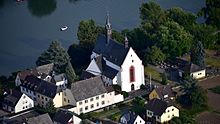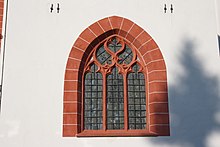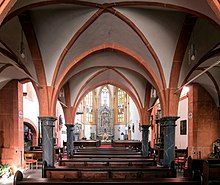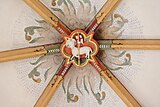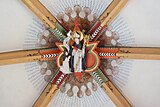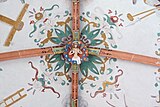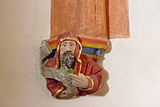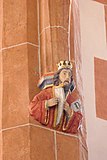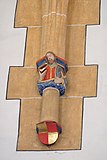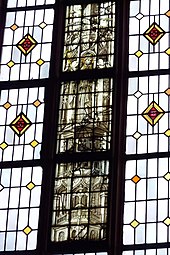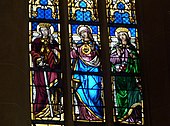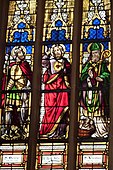St. Georg (Niederwerth)
The Catholic branch church St. Georg in Niederwerth , an island community in the district of Mayen-Koblenz in Rhineland-Palatinate , was built in the 15th century as an Augustinian canons church in the Gothic style. The church has a rich array of sculptures. In 1972 wall and vault paintings from the early 16th century were discovered and exposed again.
The St. Georg branch church is a protected cultural monument under the Monument Protection Act (DSchG) and is on the list of monuments of the state of Rhineland-Palatinate.
history
As can be seen from grave finds, the island of Niederwerth was already settled in Franconian times. The island was first mentioned in writing in the 13th century. The Archbishop of Trier had a farm there, along with other possessions, the Hasenkammerhof , where he lived when he was in Niederwerth for hunting and fishing. The English King Edward III stayed here in 1338 . when he was invited by Emperor Ludwig of Bavaria at the Koblenz Princes' Day.
In a document from the year 1275 a holy is Georg consecrated Klause handed near the episcopal farming estate, which is probably around the settlement of a Beguine community acted. After disagreements with the Archbishop of Trier Otto von Ziegenhain , the Beguines moved to Besselich near Urbar around 1428 . In addition to the cloister building, Otto von Ziegenhain handed over the archbishop's estate in Niederwerth to the Augustinian canons in Zwolle , the Netherlands , who had joined the Windesheim congregation . The Augustinians consecrated the monastery of Our Lady and began building the current church, which was consecrated in 1474.
The monastery made considerable wealth, to which the forgery of donation and purchase deeds also contributed. As a result of the Reformation , only two canons lived in Niederwerth in 1580. By order of the Archbishop of Trier and Elector Jakob von Eltz , they had to leave the monastery so that Cistercian women from Koblenz could move in against their resistance. The bishop made their buildings available to the Jesuits , who were supposed to establish a new branch in Koblenz and promote the Counter-Reformation on its territory.
Around 1600 the Cistercian women had new monastery buildings built. The few remains of the building still preserved today come from the construction phases from 1658 to 1744. Today they have been converted into apartments. In the north of the nave, three yokes of the former cloister have been preserved.
After the occupation of the Electorate of Trier by French revolutionary troops , Niederwerth and the areas on the right bank of the Rhine fell to Nassau-Weilburg and was secularized in 1811 . Buildings and lands were sold and the former monastery church was donated to the Niederwerth community. In 1954 the church was transferred to the parish. St. Georg is a branch of Vallendar and belongs to the parish community Vallendar-Urbar. From 1968 to 1974 the church was completely restored.
architecture
Exterior construction
The nave is crowned by a small baroque roof turret. A second, Gothic roof turret sits on the choir . The red window frames stand out on the white outer walls. Rosettes are painted between the windows of the south wall of the nave . The choir and west facade are supported by protruding buttresses , once stepped , which are covered with pent roofs. The southern nave, the western facade and the choir are pierced by three-lane pointed arched windows with fish bubble tracery. The windows on the north wall are bricked up.
inner space
The church is a dreijochiger hall structure , followed by a fed, dreijochiger choir in the east Five-eighth circuit is connected. The western end of the nave is formed by a four-bay gallery , the parapet of which consists of artistic tracery fields.
The ribbed vaults of the nave and choir are decorated with elaborately designed keystones on which coats of arms and figurative scenes can be seen. God the Father, the hand of God , the Lamb of God and St. Augustine are depicted on the keystones in the choir . Two keystones, the angel on the left and Mary on the right, depict the annunciation scene. On another stone stands a choirboy behind a kneeling bishop, who is identified by his coat of arms as Johann II of Baden (1434–1503). In the nave you can see the Man of Sorrows , Mary on the crescent moon and a Christ head with a crown of thorns.
The consoles are also carved with figures. In addition to the twelve apostles, they represent prophets and biblical kings.
Murals
The late Gothic frescoes depict the four church fathers with the symbols of the evangelists. Ambrosius is assigned the winged man of Matthew , Augustine the eagle of John , Hieronymus the lion of Mark and Gregory the bull of Luke . In the eastern yoke, four angels carry Jesus' instruments of passion . In other places as well, such as in the sacristy , remains of tendril and architectural paintings have been rediscovered.
Leaded glass window
Fragments of a grisaille window from 1480 were reinserted into a window in the south nave . Under a Gothic canopy is a figure that is interpreted as Bernhard von Clairvaux . Fragments of medieval panes are also integrated into the large window on the west facade.
The neo-Gothic choir windows are marked with the year 1873. In the left window, St. Catherine of Alexandria , Maria and St. Elisabeth of Thuringia , in whose robes roses are entwined, are shown. The right window shows St. George , Jesus, who points to his heart, and St. Nicholas , at whose feet the salting barrel with the three scholars stands.
Furnishing
- The neo-Gothic altar structure is framed in three rows of relief panels depicting scenes from the life of Jesus. The bottom row commemorates the Annunciation , the Visitation , the Killing of the Innocent Children and the Flight into Egypt . The themes of the middle row are the birth of Christ , the presentation in the temple and the adoration of the Magi , which occupies two tablets. The top row is dedicated to God the Father, the Resurrection , the Ascension and the Entombment of Christ . The wooden reliefs are dated to around 1520 and are assigned to the workshop of the Koblenz carver Jakob Kern or Kerre, a student of Hans Backoffen .
- The sacrament niche in the choir, to the left of the high altar, has two wooden doors with paintings on the inside and outside, which probably date from around 1520. The Annunciation scene can be seen in the closed state. On the inside, Mary on the crescent moon is depicted on the left and St. Hildegundis with a shepherd's staff and book on the right.
- In another niche in the apse, a relic is kept in a wooden box , which is venerated as the cap of St. Bernard of Clairvaux. Allegedly it came to Niederwerth through Benigna von Helfenstein , who had received the hat as a gift from Bernhard on the occasion of his visit to Germany.
- The standing Madonna figure with baby Jesus and grape, called Our Lady of Value , is dated around 1490/1500 and attributed to Tilman van der Burch.
- The two life-size figures at the front of the gallery date from the 18th century. They represent important Cistercians, on the left Bernhard von Clairvaux and on the right Robert von Molesme , the founder of the order.
- Two coats of arms on the gallery with the year 1663 remind of Heinrich von Ufflingen and his wife Barbara, the donors of the baroque extension of the gallery.
literature
- Gunnar and Rüdiger Mertens: The former Niederwerth monastery near Koblenz. Church administration council Niederwerth (publisher), 3rd improved edition with text additions, Niederwerth 2012 (texts from: Rheinische Kunststätten , issue 223, 2nd improved edition 1987, ISBN 3-88094-572-1 )
- Werner Schäfke: The Rhine from Mainz to Cologne. A journey through the romantic Rhine Valley. DuMont Reiseverlag, 4th edition, Ostfildern 2006, ISBN 3-7701-4799-5 , pp. 328–329.
Web links
- F. Büren: Monasteries and monasteries in Rhineland-Palatinate. Niederwerth Monastery. Institute for Historical Regional Studies at the University of Mainz (Project Monastery Lexicon Rhineland-Palatinate)
Individual evidence
- ^ General Directorate for Cultural Heritage Rhineland-Palatinate (ed.): Informational directory of cultural monuments - Mayen-Koblenz district. Mainz 2020, p. 76 (PDF; 5.8 MB).
Coordinates: 50 ° 23 ′ 33.8 ″ N , 7 ° 36 ′ 47.6 ″ E

